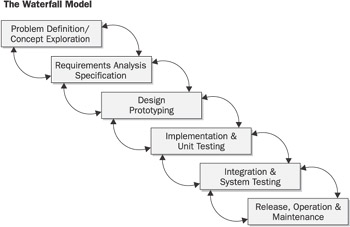Basic Web Process Model
| < Day Day Up > |
To help reduce the difficulty in constructing sites, we should adopt a process model that describes the various phases involved in Web site development. That way, each step can be carefully performed by the developer with help from guidelines and documentation, which tells them how to do things and ensures that each step is carried out properly as they go along. An ideal process model for the Web would help the developer address the complexity of the site, minimize the risk of project failure, deal with the near certainty of change during the project, and deliver the site quickly with adequate feedback for management throughout the process. Of course, the ideal process model also would have to be easy to learn and execute. This is a pretty tall order, and it is unlikely that any single process model is always going to fit the particular requirements of a project.
There are numerous process models used by people to build software and Web sites. However, the most basic process model used should be familiar to most people ”at least in spirit, as it is deductive, or more simply, "top-down." Following the top-down method, a Web project begins with the big picture and narrows down to the specific steps necessary to complete the site. Thus, the model starts first with a planning stage, then a design phase, then implementation and testing, and ends with a maintenance phase. The phases might appear to be distinct steps, but the progress from one stage to another might not always be obvious. Furthermore, progress isn't always toward a conclusion, and occasionally previous steps may need to be revisited if the project encounters unforeseen changes. The actual number of steps and their names vary from person to person, but a general idea of the procedure is shown in Figure 2-1.

Figure 2-1: The Waterfall Model
| Note | In software engineering, this model often is called the waterfall model, or sometimes the software lifecycle model, because it describes the phases in the lifetime of software. Each stage in the waterfall model proceeds one after another until conclusion. |
The good thing about this site development approach is that it makes developers plan everything up front. That also is its biggest weakness. In a Web project, there often is a great deal of uncertainty in what is required to accomplish a project, particularly if the developer has not had a great deal of Web development experience. Another problem with this development model is that each step is supposed to be distinct, but the reality is that in Web development, like software, steps tend to overlap, influence previous and future steps, and often have to be repeated. Unfortunately, the basic Web site development approach can be fairly rigid and might require the developer to stop the project and redo many steps if too many changes occur. In short, the process doesn't deal well with change. However, this simple model for site design continues to be very popular because it is both easy to understand and easy to follow. Furthermore, the distinct steps in the process appeal to management as they can easily be monitored and serve as project milestones.
| < Day Day Up > |
EAN: 2147483647
Pages: 252